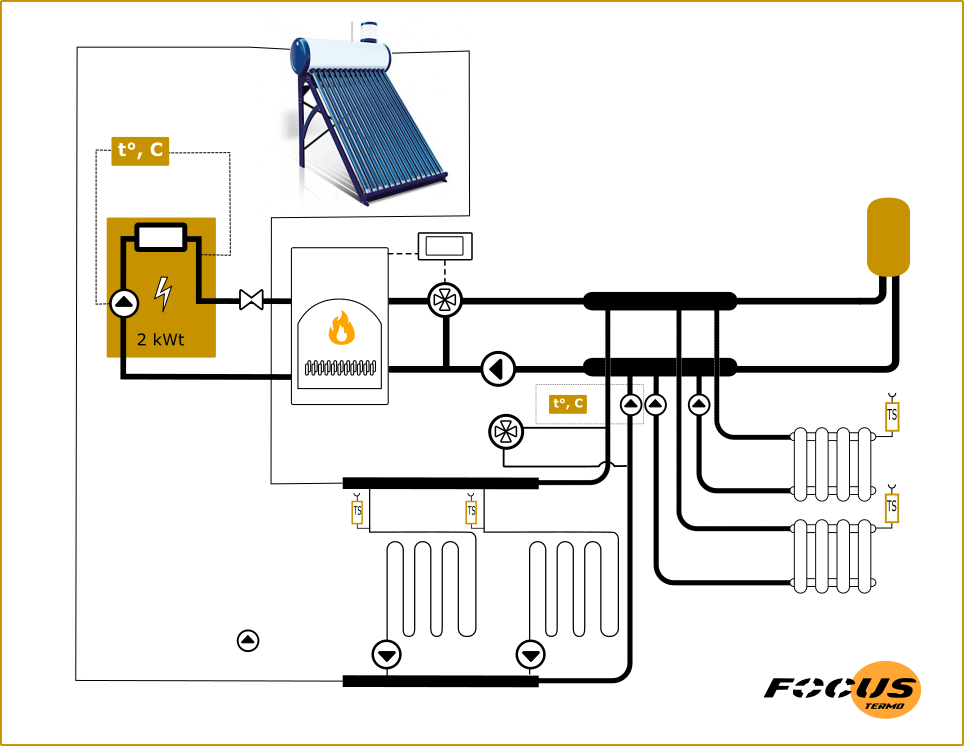Heating of a private house built using frame technology
Heating a private house, which is built using frame technology, has its own characteristics. On the one hand, as with any type of building, there are several heating options that can be considered depending on your preferences, climate conditions and fuel availability. On the other hand, it is the frame structure that presupposes heating features associated with its insufficiency. Let's analyze them in combination with available heating technologies. Here are some of them:
Electric heating
This is one of the simplest options that is suitable for frame houses. Electric heaters, infrared panels or electric heated floors can be used to heat rooms.



This heating option in a frame will only be effective if infrared heat is used, which is not only useful, but also heats the body directly. The convective type of heating in this case is not very effective, since objects are heated that quickly cool down in the frame.
For this reason, if you still want to use electric heating, it is better to heat the floor, taking into account the increased heat loss and the perimeter of the house. This can classically be realized from heated floors and radiators around the perimeter. For more intense heat in cold weather, fireplace heating will be useful. These technologies can be combined, taking into account fire safety requirements. In addition, it will be useful to use solar heat and solar systems to heat heated floors and hot water from the sun during the off-season. Schematic diagrams of these heating options for a private house are shown in the illustrations.
Gas heating
If you have access to gas, a gas boiler or gas heaters can be installed to heat your frame house. Gas systems are often considered more efficient and economical. They are convenient to use, but quite high operating costs. To reduce them, you need to use climate control, that is, adjustable heating circuits, and heating scenarios that reduce the heat intensity when there are no people in the house.
Pellet fireplaces or boilers
Pellets are compressed wood waste that can be used in special pellet boilers or fireplace inserts for home heating. This is an environmentally friendly, provided combustion products are burned, and an effective method of heating.
The efficiency of the FOCUS pellet boiler with a torch burner reaches 94%, the smoke that comes out of the boiler contains almost no combustion products and heat, it is effectively removed by heat exchangers. Savings on heating a private house with pellets reaches 50-70%, that is, you don’t have to limit yourself in heat. On the basis of a pellet boiler, you can deploy water and air heating of a private house and heated floors.
Heat pumps
Air source or geothermal heat pumps can be used to heat frame houses. They extract heat from the environment and transfer it inside the house. The problem with this technology is its low power, when heating a frame house requires more heat due to high heat losses.
Wood or pellet stoves
If you have access to wood or pellets, wood or pellet stoves can be a good choice for heating a frame home. They provide warmth and create a cozy atmosphere. Fireplace heating combines infrared heat and air heating; for this reason, when safely equipping stoves, this type of heating remains a priority on a low budget.
Air heating of a private house
However, forced-air heating, or forced-air heating, is indeed the most common choice for frame homes. For these purposes, a central ventilation system is used, which heats the air and distributes it throughout the house through ventilation ducts or air ducts.
This heating system provides even heat distribution and is generally easy to operate. In addition, it can be easily integrated with air conditioning to ensure comfortable temperatures throughout the year. Also, with air heating, air is recirculated from top to bottom, when naturally warm air accumulates under the ceiling and is recirculated to the floor, which increases the efficiency of the available heat.
The disadvantage of air heating is the need for installation during construction and renovation. However, there are also low-cost deployment options.
Eventually…
When installing heating, take into account the size, its insulation, climatic conditions and the availability of fuel when choosing a heating system for a frame house. It is recommended that you consult with a heating professional to determine the best option based on your needs and conditions. We can give you extensive advice if you choose FOCUS heating equipment.







